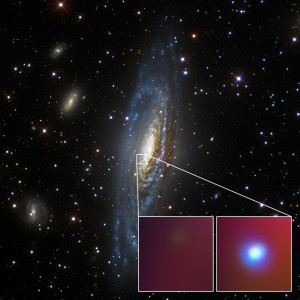Our bodies are largely composed of the material generated from nuclear reactions in ancient stars. And not only our bodies, but our planet and solar system as well.
When a star explodes, newly-formed elements are ejected into the universe. When they explode, the violent deaths of stars are called supernovae.
A supernova that is 36 million to 46 million light-years away is challenging astronomers’ models of how exploding stars distribute their elements.
Over the course of a year, one supernova changed in appearance. Throwing off a considerable amount of material late in life, the supernova is causing scientists to reconsider how enormous stars live before they explode. This unusual supernova, SN 2014C, doesn’t fit into any recognized categories of how a stellar explosion should happen.
According to Raffaella Margutti who led a study about this particular supernova that was published in The Astrophysical Journal this week, the supernova could “represent a new mechanism of how massive stars deliver elements created in their cores to the rest of the universe.”
Exploding stars are classified based on the presence or lack of hydrogen. Supernovae with very little hydrogen are ‘Type I.’ More rare are supernovae with an abundance of hydrogen, called ‘Type II.’
Margutti referred to SN 2014C as a ‘chameleon supernova.’ Following the collapse of its core, the supernova transformed itself from a Type I to Type II.
Stars begin their lives with hydrogen fusing into helium. When large stars run out of hydrogen as fuel, they are approaching a supernova death.
The visible-light image below shows spiral galaxy NGC 7331 where this unusual supernova was observed. The inset images show a region of the galaxy before the explosion of the supernova on the left and after the explosion on the right.
In the two inset images, red, green and blue are used for low, medium and high-energy X-rays, respectively.
Spiral galaxy NGC 7331. Image credits: X-ray images: NASA/CXC/CIERA/R.Margutti et al; Optical image: SDSS
To conclude the supernova’s transformation from Type I to Type II, various ground-based telescopes were used by astronomers to look at SN 2014C in optical wavelengths. This was reported in a 2015 study led by Dan Milisavljevic at the Harvard-Smithsonian Center for Astrophysics in Cambridge, Massachusetts.
Hydrogen was not detected in the initial observations. After about a year, it was found that shock waves coming from the explosion were hitting a material outside of the star that was dominated by hydrogen.
By using NASA’s NuSTAR (Nuclear Spectroscopic Telescope Array) satellite in the new study, scientists were able to observe the highest-energy X-rays. This gave them the ability to see how the temperature of electrons accelerated by the shock of the supernova changed over time, and they used it to estimate how fast SN 2014C expanded and the amount of material in its external shell.
How was the shell created? The supernova threw off a lot of material before exploding – decades to centuries beforehand. The material was mostly hydrogen but also heavier elements. Stars do not usually throw off material so late in their life, and what’s more, the material ejected by the star was equivalent to the mass of the sun!
To help understand the evolution of the supernova, a collection of observations from NASA’s Chandra and Swift observatories was used, showing that SN 2014C brightened in X-rays after the initial explosion. This showed that a shell of material previously ejected by the star must have been present and hit by the shock waves.
Although puzzling to contemplate why so much hydrogen would be thrown off before the star exploded, one theory points to something absent in our understanding of nuclear reactions in the cores of giant stars that are supernova-prone. A different possibility is that SN 2014C did not die alone. Perhaps a companion star in a binary system influenced the life and death of the predecessor of SN 2014C. Approximately seven out of ten giant stars have companions.
“The notion that a star could expel such a huge amount of matter in a short interval is completely new,” said NuSTAR principal investigator Fiona Harrison. “It is challenging our fundamental ideas about how massive stars evolve, and eventually explode, distributing the chemical elements necessary for life.”
Learn more about NuSTAR at NASA.gov.


